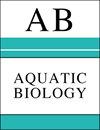Plasticity of foot muscle and cardiac thermal limits in the limpet Lottia limatula from locations with differing temperatures
IF 0.8
4区 生物学
Q3 MARINE & FRESHWATER BIOLOGY
引用次数: 4
Abstract
Likelihood-ratio tests comparing the goodness-of-fit between the null model and alternative model were used to further evaluate the hypothesis that limpets of higher CTmax have reduced plasticy. Based on the assumption that limpet CTmax responds to local temperatures with plasticity, the null linear regression model included site and acclimation as the only two explanatory variables predicting CTmax. The alternative model included the interaction between acclimation and site as an additional explanatory variable. If the alternative hypothesis significantly fitted the observations better, coefficient estimates of the interaction between acclimation and site were compared to see how plasticity differed among sites. Null and alternative hypothesis models’ goodness-of-fit was also compared using AICc.不同温度条件下帽贝足部肌肉和心脏热限的可塑性
使用似然比检验比较零模型和备选模型之间的拟合优度,以进一步评估较高CTmax帽贝塑性降低的假设。基于帽贝CTmax对局部温度的响应具有可塑性的假设,零线性回归模型仅将场地和驯化作为预测CTmax的两个解释变量。备选模型包括驯化和地点之间的相互作用作为附加的解释变量。如果另一种假设更符合观察结果,则比较驯化和地点之间相互作用的系数估计值,看看不同地点之间的可塑性有何不同。用AICc比较了原假设模型和备择假设模型的拟合优度。
本文章由计算机程序翻译,如有差异,请以英文原文为准。
求助全文
约1分钟内获得全文
求助全文
来源期刊

Aquatic Biology
生物-海洋与淡水生物学
CiteScore
2.70
自引率
0.00%
发文量
7
审稿时长
3 months
期刊介绍:
AB publishes rigorously refereed and carefully selected Feature Articles, Research Articles, Reviews and Notes, as well as Comments/Reply Comments (for details see MEPS 228:1), Theme Sections, Opinion Pieces (previously called ''As I See It'') (for details consult the Guidelines for Authors) concerned with the biology, physiology, biochemistry and genetics (including the ’omics‘) of all aquatic organisms under laboratory and field conditions, and at all levels of organisation and investigation. Areas covered include:
-Biological aspects of biota: Evolution and speciation; life histories; biodiversity, biogeography and phylogeography; population genetics; biological connectedness between marine and freshwater biota; paleobiology of aquatic environments; invasive species.
-Biochemical and physiological aspects of aquatic life; synthesis and conversion of organic matter (mechanisms of auto- and heterotrophy, digestion, respiration, nutrition); thermo-, ion, osmo- and volume-regulation; stress and stress resistance; metabolism and energy budgets; non-genetic and genetic adaptation.
-Species interactions: Environment–organism and organism–organism interrelationships; predation: defenses (physical and chemical); symbioses.
-Molecular biology of aquatic life.
-Behavior: Orientation in space and time; migrations; feeding and reproductive behavior; agonistic behavior.
-Toxicology and water-quality effects on organisms; anthropogenic impacts on aquatic biota (e.g. pollution, fisheries); stream regulation and restoration.
-Theoretical biology: mathematical modelling of biological processes and species interactions.
-Methodology and equipment employed in aquatic biological research; underwater exploration and experimentation.
-Exploitation of aquatic biota: Fisheries; cultivation of aquatic organisms: use, management, protection and conservation of living aquatic resources.
-Reproduction and development in marine, brackish and freshwater organisms
 求助内容:
求助内容: 应助结果提醒方式:
应助结果提醒方式:


